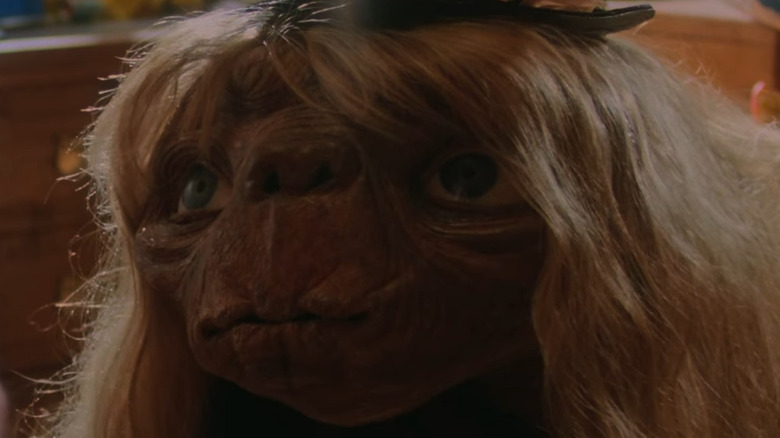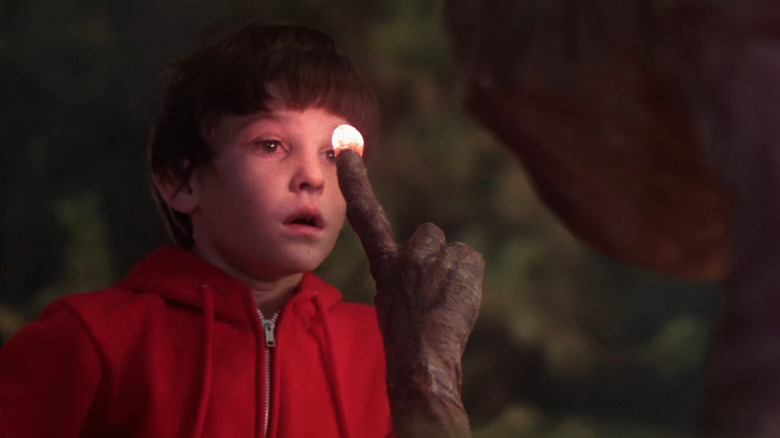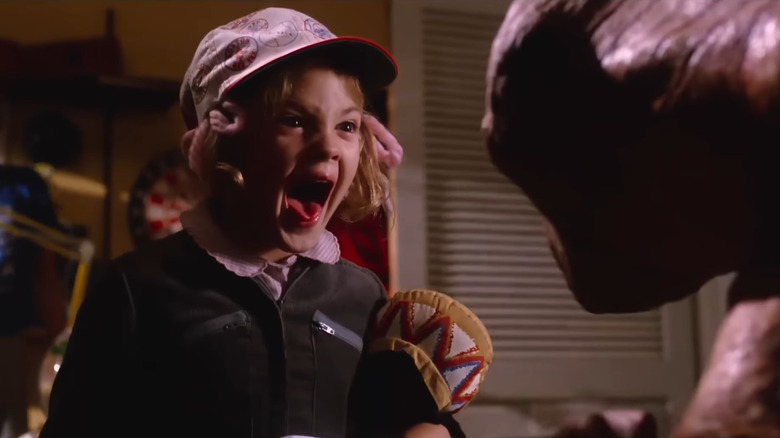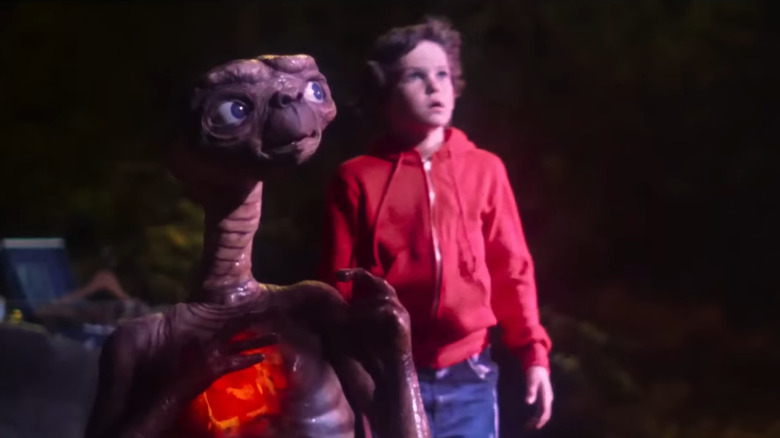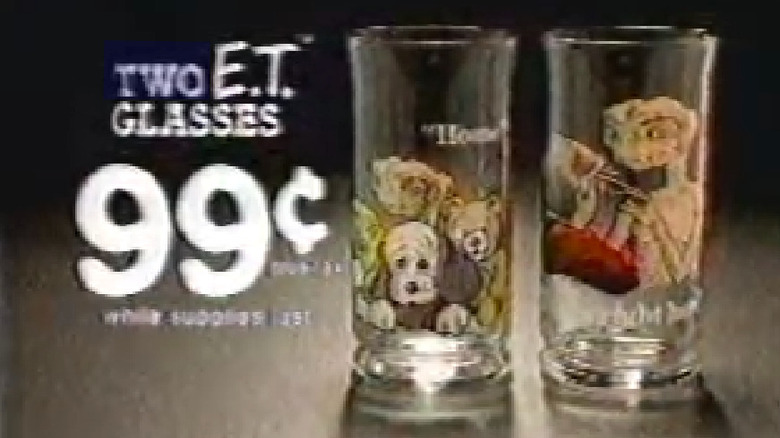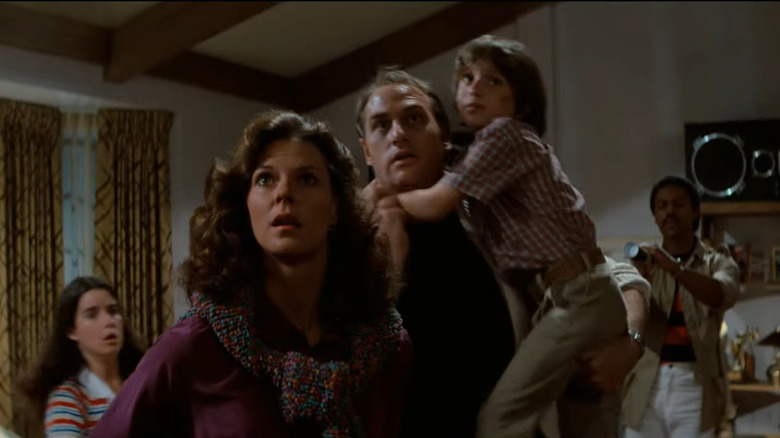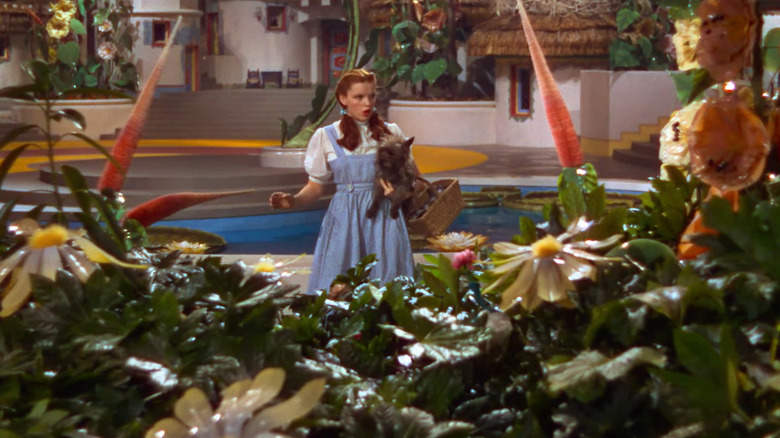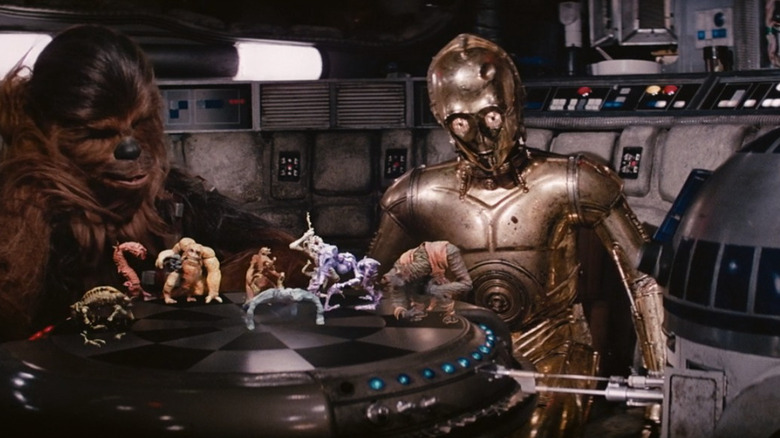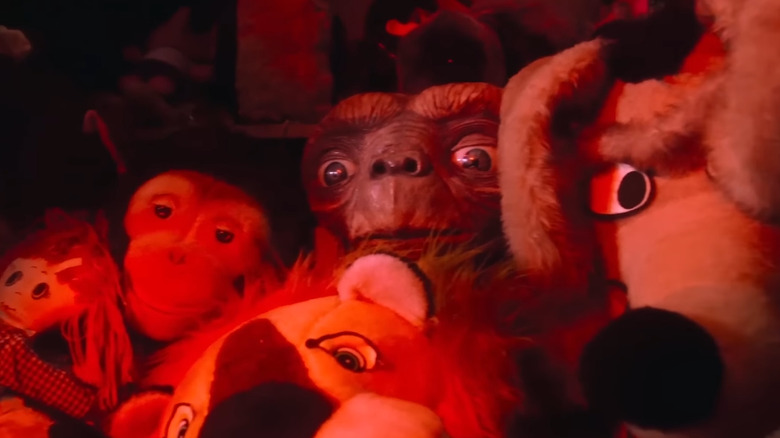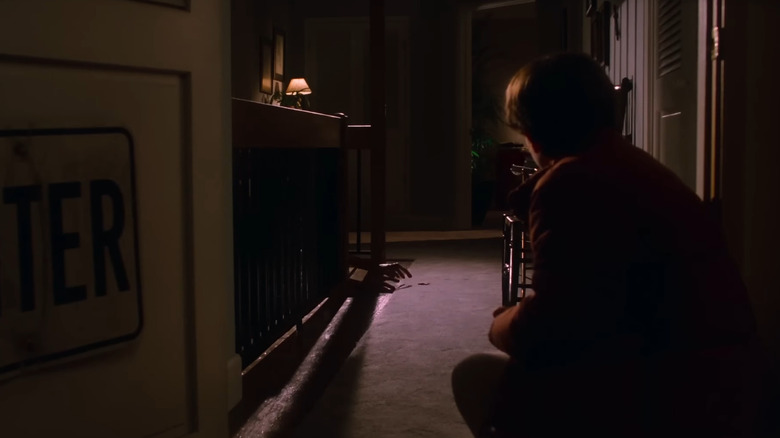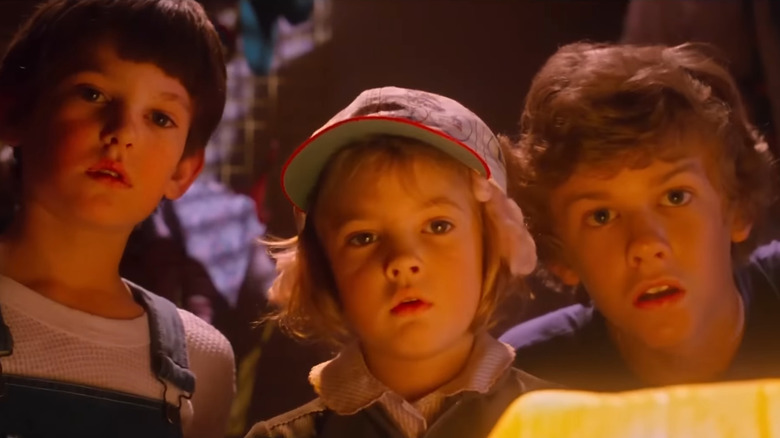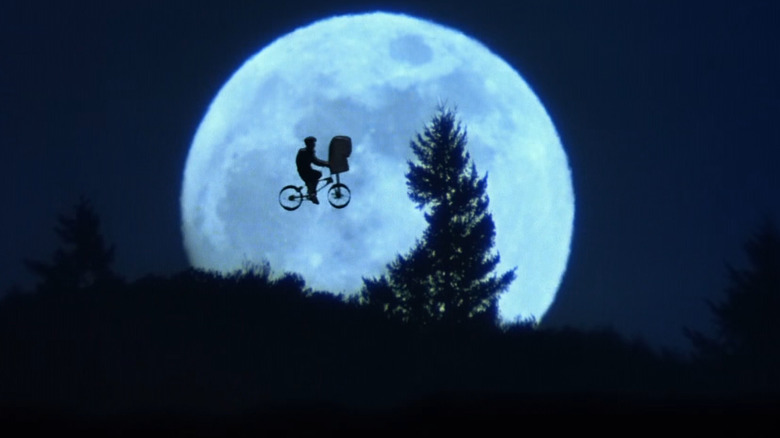What It Was Really Like To See E.T. In 1982
An undisputed classic and arguably the pinnacle of director Steven Spielberg's filmography, "E.T. the Extra-Terrestrial" has the good fortune of being reintroduced to audiences generation after generation. Maybe you just recently shared "E.T." with your family in IMAX or on Peacock as the film celebrated its 40th anniversary. Perhaps you first discovered the charming tale yourself in 2002, when Spielberg released a special edition of the movie in theaters. Or maybe you were among the lucky masses that met the alien when he first made his way to the screen in 1982 and became a global phenomenon.
"E.T." is among a rare group of Hollywood megahits to never have received a sequel. (Though Spielberg tried to write a follow-up, he later abandoned it.) For cinephiles and casual moviegoers alike who wish to revisit the story, there's only one movie to turn to, making it even more of a precious commodity.
In 1982, that commodity began its meteoric journey to become mythic. Spielberg, just one year after helming the seemingly unstoppable "Raiders of the Lost Ark," wowed audiences yet again. What was the world's first impression of this creature? How did "E.T." make an imprint upon popular culture before there was any sort of beloved attachment to it? Let's find out.
The best Disney film Disney never made
Universal Pictures released "E.T.," but many audience members remarked how the film seemed so much like a Disney movie. A story focused on children, a fantastical creature from another world, a sweeping score to give it a storybook feel — "E.T." shares these qualities with many Disney favorites, and this observation was a recurring one when the film first debuted in 1982.
Writing for Variety, Todd McCarthy wrote that the movie "may be the best Disney film Disney never made," calling it "captivating, endearingly optimistic, and magical at times." The Guardian's review described some of the film's setting as a "Disneyesque wood," and noted that beyond the story itself, the film spawned "more connected merchandise than even Mickey Mouse did." Within its fictional narrative and outside of it, "E.T." felt inherent of Disney's DNA.
This was something Steven Spielberg himself was aware of and even strived for. In 2012 for the film's 30th anniversary, he reflected, "In those days, Disney films had lost their audience and were not as popular as they once had been. Disney was a stigma in the early '80s, but I still felt that I had made a Disney film." He's right. If "E.T." had been a Disney movie, it would have been the most memorable of its era, with Disney's big project in production at the time being "The Black Cauldron," an infamous bomb.
Some children were terrified of E.T.
E.T. might be from another planet, but he's not depicted as a scary monster. He's kind, empathetic, and for the most part, very calm. Nonetheless, the alien haunted a generation of kids in their nightmares, and in 2016 a handful of grown-ups found therapeutic relief in sharing their horrific childhood dreams on Reddit.
User ZephyruSOfficial wrote, "When I was younger, my parents bought me a lifesize moving, speaking E.T. with a glowing finger. It scared the absolute f*** out of me. One day I just snapped and beat the f*** out of it until it didn't work anymore." Likewise, JLM1988 said, "Well I'm glad to know I'm not the only one. I had nightmares for years after I saw 'E.T.' It was the same dream every single time. He would chase me around the house and then touch my back with his disgusting glowing sausage finger. I would wake up screaming." Their parents even went as far as sprinkling salt around their bed to assure them E.T. would stay away! "Thank god it all eventually stopped but I will never show my kids that damn movie."
This was a facet of the "E.T." phenomenon that adults in 1982 did not, or perhaps could not, fully understand. On the contrary, Variety described the titular character as "cutely awkward" and projecting "wondrous childlike quality" in its review. A handful of younger viewers might beg to differ. (Though, on the other side of the spectrum, there are plenty of things in "E.T." adults noticed that went over kids' heads, too.)
Not a dry eye in the house
Over the course of the film, Elliott and E.T. form a strong bond. E.T. is in a completely new place, and Elliott is the only person to truly accept him and protect him at all costs. Likewise, Elliott finds in E.T. a source of unconditional friendship. Along the way, the audience becomes completely captivated by Elliott and E.T.'s relationship — exactly as the filmmakers intended. When the time comes for E.T. to return to his home planet, he has to leave Elliott. Cue the waterworks. And that's not even to mention the other sad parts of the film such as when it appears that E.T. is dead and a heartbroken Elliott mourns for his seemingly deceased friend.
Audiences in 1982 were moved. In a 1996 documentary, the film's child actors — by then adults — recalled their memories of the emotional chord "E.T." struck. Henry Thomas, who played Elliott, said, "I remember the first time I'd ever viewed it, I came out and I said, 'They ought to pass out crying towels to the audience 'cause it was very moving.' I remember everybody in the theater was in tears." Drew Barrymore, who played Elliott's sister, Gertie, seconded the memory. "Everyone," she said. "The term 'not a dry eye in the house,' I think, if it wasn't created there, it definitely applies."
No one out-pizzas the Hut ... except E.T.
In 1982, Pizza Hut customers could nab some exclusive "E.T." merch. Any purchase of a medium or large pan pizza unlocked the opportunity to buy two 16-ounce "E.T." glasses for 99 cents. There were four glasses total, each a clear glass painted with a scene from the movie. This followed a trend at the time which also included "Star Wars" glasses at Burger King and "Great Muppet Caper" glasses at McDonald's. (Anyone who still has these glasses today, though, don't drink out of them, as they're likely a source of lead poisoning.)
The Pizza Hut glasses were just a small example of the armada of merchandise available in the '80s. As evidenced in an image gallery on the Blu-ray release of "E.T.," anything and everything could seemingly be made into a tie-in with the movie. Some of these creatively made sense with the story, like "E.T."-branded bicycles or a questionably shaped "finger light." Overall, though, if it could be sold, it got E.T.'s image slapped on it, from wristwatches and tote bags to play trays and backpacks. Today, you might not be able to find much "E.T." merch as abundantly available nationwide, but the gift shop at the exit of the "E.T." ride at Universal Studios Florida still keeps its shelves stocked with "E.T." everything.
A Spielberg cinematic universe?
Steven Spielberg wrote the Tobe Hooper-directed supernatural thriller "Poltergeist," which debuted the same year as "E.T." With the former fresh on the audience's mind while viewing the latter, one reviewer suggested the films could take place in the same neighborhood and their stories would make sense.
In 1982 Variety's Todd McCarthy wrote how the suburban setting of both films favor each other and posed a theory that "the two, distinctly different stories could be unfolding in neighboring homes simultaneously. Many of the motifs in the early going are similar to those in 'Poltergeist' — the middle-class family, the blonde dog, goldfish, people glaring into bright lights in awe and disbelief."
E.T. is decidedly more friendly than the otherworldly visitors in "Poltergeist," but the comparison is nonetheless fun to imagine fully fleshing out if studios of the '80s were as hungry for interconnected cinematic universes as today's Hollywood is.
The Wizard of Oz in reverse
"E.T." is a fish-out-of-water story. The titular character, a non-human species, finds himself lost in a typical American community a great distance away from his planet on the other side of the galaxy. In this regard, "E.T.," whether subconsciously or by design, seems to be a subversion of "The Wizard of Oz," which in 1982, had already been revered as a Hollywood classic for four decades and as a literary classic for nearly a century.
The Guardian noted how "E.T." suggested a flipped spin on the tale: "What would it be like, we're asked, if Frank Baum's story were reversed and a Munchkin came down to earth needing the assistance of a lonely, middle-American Dorothy to help him return home?" Taking the reviewer's idea a step further, one could parallel E.T.'s recurring plea to "phone home" with Dorothy's famous mantra, "There's no place like home."
E.T. beat a Star Wars record
"E.T. the Extra-Terrestrial" not only won over critics, but it was also a huge financial success. The film ultimately became the top-earning domestic movie ever (up until that point), beating a previous record set by 1977's "Star Wars" and thus participating in a tradition among filmmakers of using their characters to congratulate the next film to achieve this success. When "E.T." topped "Star Wars" in 1982, George Lucas' team sent a celebratory illustration of "Star Wars" characters hoisting E.T. on their shoulders. (In 1997 when a "Star Wars" reissue reigned as champion again, Spielberg's team returned the favor with an illustration of E.T. adorning R2-D2 with a crown.)
Today, "E.T." remains a top earner in movie history. According to Box Office Mojo, at the time of this writing, the film is the 25th highest-grossing domestic movie ever (with $437 million), which would be bumped to fourth place if adjusted to 2022 dollars (to equal $1.3 billion). That would place "E.T." only behind 1965's "The Sound of Music," 1977's "Star Wars," and 1939's "Gone with the Wind" for most domestic tickets sold. Worldwide, "E.T." sits at #98 with a lifetime gross of just under $793 million. Not too shabby for a little alien.
Studio executives saw the movie just like the audience did
"E.T. the Extra-Terrestrial" was close to Steven Spielberg's heart. As such, he wanted to protect the movie's integrity from interference from studio executives. Typically, bigwigs will review in-progress versions of films and provide feedback. Spielberg feared that executives might be unable to understand the full vision or scope of "E.T." in its unfinished form, and therefore mandate creative changes that, even with the best intentions, would be unwarranted. In a break from tradition, Spielberg convinced Universal to wait to see the movie until he could show it to them on his terms.
Reflecting in 2012, Spielberg said, "I didn't want to show it to the studio without an audience, so I invited the studio to see the film the first time I previewed the picture in Texas. That was the only time I wanted the studio ever to see the picture. It was scored. The color was corrected. It was a finished movie." The audience response was beyond anything Spielberg could have hoped, especially given the important personnel in the room. Spielberg continued, "It was a buoyant, unprecedented reaction. I had never experienced anything like that except 'Jaws,' but 'Jaws' was filled with screams, and 'E.T.' was filled with laughter and some genuine tears." It was a smart move. The studio executives were "flying high," and Spielberg got to debut "E.T." to the world as he intended.
A sudden craving for Reese's Pieces
"E.T." famously skyrocketed sales of Reese's Pieces after audiences saw the alien star eat the candy onscreen. In the summer of 1982, People interviewed Jack Dowd, vice president of new business development for Hershey Chocolate, about the saga. Dowd emphasized the risk involved, with Hershey spending $1 million on "E.T."-branded promotion such as stickers on Reese's Pieces packaging calling it "E.T.'s favorite candy" with no guarantee that the film would be successful. Steven Spielberg's filmography at the time was sprinkled with hits (like "Raiders of the Lost Ark") and misses (like "1941"). Which way would "E.T." swing?
Thankfully, the movie was adored — and suddenly, so were Reese's Pieces. In 2001, Entertainment Tonight wrote that sales for the candy boomed 65 percent after "E.T." debuted. Reese's Pieces hadn't always been the plan, though. Producer Kathy Kennedy told Entertainment Tonight how the crew had initially been in touch with Mars about E.T. eating M&M's, but the candy giant wasn't comfortable approving the use of their brand without seeing footage, which a protective Spielberg refused to show them. "When we were running out of time and [Mars] hadn't given us the OK, we went to Reese's Pieces and the rest is history," Kennedy remembered. "I think they had a lot of regret after saying no."
E.T.'s child actors were instant stars
As siblings Elliott and Gertie in "E.T.," Henry Thomas and Drew Barrymore became overnight stars despite their young age. In 1996, the pair recalled in a documentary interview their lives completely changing from that moment and feeling like they needed to live in a bubble in 1982 and 1983.
"Everything sort of changed after that, and also, it was very, very overwhelming, but in a great way," Barrymore said. Thomas had mixed feelings. "It's odd because I remember being really bitter as an 11-year-old boy because I couldn't go anywhere," Thomas said. "I couldn't do anything. I was kind of a prisoner in my own home for about a year. If people didn't recognize me right away, I would look familiar to them somehow."
Barrymore noted how their likenesses were instantaneously everywhere thanks to the expansive line of consumer products that prominently tied in with "E.T." Their fame wasn't confined to a movie screen. It was inescapable. Barrymore continued, "Trying to embrace life on that level I think was hard, being as young as we were."
A dream come true
With any successful film, especially one that achieves as gargantuan acclaim, notoriety, and immortality as "E.T.," one can't help but hope that the cast and crew involved in its creation enjoy the movie as much as the public does, and if they like forever being connected to it because like it or not, they will be. For Steven Spielberg, at least, "E.T." holds a special place in his heart just like it does for the public.
In bonus material on the film's 2012 Blu-ray, Spielberg shared how he saw an early cut of the film for the very first time with editor Carol Littleton. Spielberg's first reaction after seeing it? "I think I knew at that point that this was a dream come true," he remembered "I didn't ever think I'd make a movie as good as 'E.T.'" There was still a lot of work to do at that point, and he and Littleton eventually trimmed 40 minutes out of that first version, but Spielberg admitted he felt the film's impact even in its early cut. He continued, "You're not supposed to fall in love with your own movie, but I fell in love with 'E.T.' I fell in love with that picture. That was even without the John Williams score. That was very early in the process."
